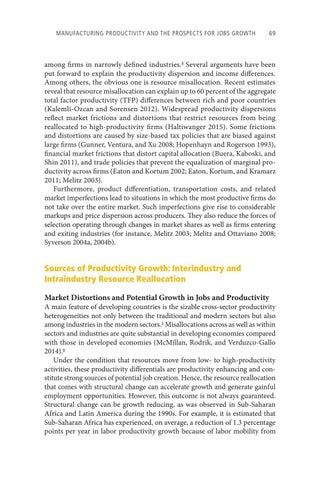MANUFACTURING PRODUCTIVITY AND THE PROSPECTS FOR JOBS GROWTH 69
among firms in narrowly defined industries.4 Several arguments have been put forward to explain the productivity dispersion and income differences. Among others, the obvious one is resource misallocation. Recent estimates reveal that resource misallocation can explain up to 60 percent of the aggregate total factor productivity (TFP) differences between rich and poor countries (Kalemli-Ozcan and Sorensen 2012). Widespread productivity dispersions reflect market frictions and distortions that restrict resources from being reallocated to high-productivity firms (Haltiwanger 2015). Some frictions and distortions are caused by size-based tax policies that are biased against large firms (Gunner, Ventura, and Xu 2008; Hopenhayn and Rogerson 1993), financial market frictions that distort capital allocation (Buera, Kaboski, and Shin 2011), and trade policies that prevent the equalization of marginal productivity across firms (Eaton and Kortum 2002; Eaton, Kortum, and Kramarz 2011; Melitz 2003). Furthermore, product differentiation, transportation costs, and related market imperfections lead to situations in which the most productive firms do not take over the entire market. Such imperfections give rise to considerable markups and price dispersion across producers. They also reduce the forces of selection operating through changes in market shares as well as firms entering and exiting industries (for instance, Melitz 2003; Melitz and Ottaviano 2008; Syverson 2004a, 2004b).
Sources of Productivity Growth: Interindustry and Intraindustry Resource Reallocation Market Distortions and Potential Growth in Jobs and Productivity
A main feature of developing countries is the sizable cross-sector productivity heterogeneities not only between the traditional and modern sectors but also among industries in the modern sectors.5 Misallocations across as well as within sectors and industries are quite substantial in developing economies compared with those in developed economies (McMillan, Rodrik, and Verduzco-Gallo 2014).6 Under the condition that resources move from low- to high-productivity activities, these productivity differentials are productivity enhancing and constitute strong sources of potential job creation. Hence, the resource reallocation that comes with structural change can accelerate growth and generate gainful employment opportunities. However, this outcome is not always guaranteed. Structural change can be growth reducing, as was observed in Sub-Saharan Africa and Latin America during the 1990s. For example, it is estimated that Sub-Saharan Africa has experienced, on average, a reduction of 1.3 percentage points per year in labor productivity growth because of labor mobility from

